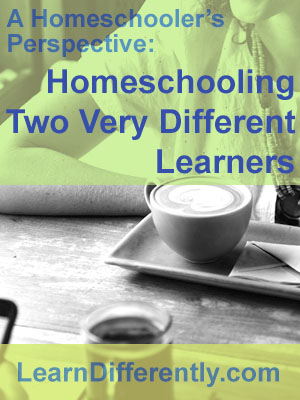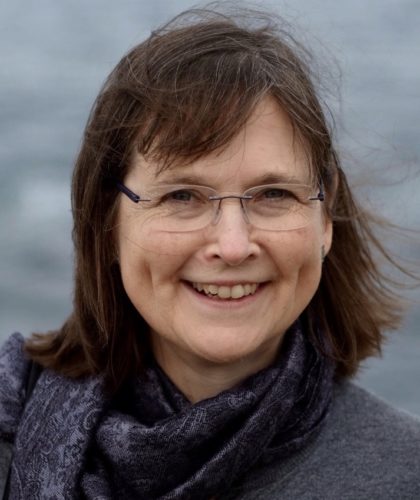A Homeschooler’s Perspective: Two Very Different Learners

By Kathy Kuhl Last month, I had coffee with a homeschooler I hadn’t seen in years. We met to talk about what she had learned homeschooling two exceptional, dynamic, and wildly different children. To preserve her their privacy, I’ll call the mother “Ann.”
Doctor suggested her daughter be institutionalized
I knew that Ann was creative, determined, and resourceful. But there was so much I hadn’t known. I’d taught Ann’s daughter, “Beth,” but I had no idea how severe her impairments had been. (I’d met her when she was a teen, after she’d made great progress.)
Years before, doctors had told Ann that her daughter would never walk. One doctor even suggested Beth could be institutionalized. Beth has an unusual combination of challenges. But she never received any formal or specific diagnoses. Like some of your children, she didn’t fit neatly into the categories.
No diagnosis meant less support for Ann—no group of other moms, homeschooling or not, with a child quite like Beth. So, Ann says, it was just her and God. (Ann is a Christian.) There was little on the Internet then, so Ann researched at the library extensively, for years.
Beth’s mix of issues needed special adaptations. For one, Beth is slow to make decisions. Beth also is highly sensitive to textures. As a small child, she could not stand to walk barefoot on the grass. So Ann made books to teach different textures to help Beth adjust to them: books with sandpaper pages, fluffy pages, and so on. Like some of you, Ann and her husband had to help Beth in these and countless other areas.

Ann’s Favorite Neurodevelopmental Resources
Ann said that two resources she found helpful were Dr. Caroline Leaf, now on YouTube, and Dr. Glenn Doman, who researched therapies for kids with brain injuries. He founded The Institutes for the Achievement of Human Potential in Glenside, Pennsylvania. Ann used their neurodevelopmental approaches with both children.
What’s a neurodevelopmental approach? This approach recognizes that for proper development, humans need to go through different stages of activity. It’s a holistic approach, reflecting the complex interactions within the human brain. For instance, children must crawl before learning to walk for proper brain development.
Kids who skip those stages need to go back and practice the skills they missed. Therapists provide neurodevelopmental exercises, which children practice extensively at home. (See my review of Too Wise to Be Mistaken, Too Good to Be Unkind: Christian Parents Contend with Autism, in then Resource section below, for a description by parents who helped their autistic son with neurodevelopmental therapy.)
Struggles in School
Because of her special needs, Beth received services through ChildFind at age three. Meanwhile, Ann taught at a Christian school using the ABeka curriculum to teach K4 and K5. That was a great thing for Beth’s big brother, Joshua. Advanced academically, Josh loved this academic program.
Already, Josh was reading at age 5. Yet he had never crawled. Instead he just started walking at seven months. As Ann learned about neurodevelopmental therapy, she also started making Josh practice crawling and other exercises.
When he turned six, the family moved to the Washington DC area. They tried putting both children in in public school. It was not a success.
In first grade, Josh’s teachers taught the number one on day one, two on day two, three on day three, and so on. For Josh, it was an excruciatingly slow review of what he already knew. They were teaching the first graders to read. But Josh was already reading the Boxcar Children series. Naturally, he became bored in class. He grew disruptive.
At that point Josh’s ADHD was undiagnosed. Ann said that the school wanted him to take medication, but she told them he needed to get outside more.
Meanwhile Beth, at age four, was more advanced than her peers in the special-needs classroom at public school. Instead of getting instruction, Beth was working as a teacher’s helper.
She began to regress. Beth stopped asking for things using words and would merely open and close her hand. Ann said that Beth’s school focused on what she couldn’t do, instead of what she could. Ann got a strong sense that God was telling her, “Take them home.“
Seven Lessons from this homeschooler
So Ann began to homeschool when her children were five and seven. What did she learn?
Lesson One: Diet can make a big difference
Friends in her homeschool group told her about the Feingold diet. It helped her son tremendously. (See below for more about diet and learning.)
Lesson Two: Different kids have different learning styles. (So do parents.)
Teaching Josh and Beth together was challenging. Josh loved timed tests, but they would always make Beth cry. Josh loved the pace of ABeka, which wasn’t a good fit for Beth. He resented repetition in lessons and he resented having to show work. But his sister needed repetition and hands-on experiences to grasp many concepts.
ABeka’s structure suited Ann, and she liked sticking to a schedule. But her son was very kinesthetic and also very good at abstract reasoning, and many aspects of the curriculum didn’t suit Beth’s needs. She needed to modify the program.
So Ann started making lots of changes. At home she created a mock-up shoe store to help her daughter learn math concepts and practice techniques. Meanwhile she began to give Josh lots of kinesthetic learning activities, such as practicing spelling words in chalk on the sidewalk.
Ann advises, “Learn your kids and go have fun.” The first year, she urged, “You should have fun.” And the fun grew in the years ahead.
Lesson Three: Change the focus and the teaching style
Ann’s next big insight came after her second year of homeschooling. Over the summer, she spent much time praying about whether to continue homeschooling. The preparation and scheduled work for these two very different learners left her feeling frantic.
At a homeschoolers meeting, she found a copy of the KONOS curriculum on the giveaway table. She said, “It was life-changing. The first year KONOS curriculum focused on character, which was exactly what the kids needed.”
Unit studies from KONOS transformed their homeschool. (In unit studies, for several weeks, the entire homeschool connects to a common theme, like dinosaurs, pioneer life, ancient Greece, and so on.) To this day, when the family does something really fun, Ann recalls, “the kids look at each other and say, ‘KONOS!’”
Lesson Four: Less Pressure, More Love of Learning
Recall that Ann is a very structured, organized person, so switching to unit studies was a big change. Less structure gave her more freedom to flex when necessary. “We would often go outside if the kids were melting down, and turn it into a science exploration day,” she said. “Our best days were sitting on the couch reading together.”
Ann also filed for religious exemption, a homeschool option in Virginia that did not require them to submit standardized test scores each year. She still had the kids tested, however, for her own sake. They discovered Josh made even more progress with unit studies than he had with a traditional approach.
One year they focused on the arts, beginning with Botticelli. That year covered visual art, music, and other arts. Writing was incorporated into the lessons, Ann explained.
Unit studies made the kids love to learn. At nine o’clock at night, the kids would still be asking questions and wanting to work on school projects. She caught Josh in bed with a flashlight after lights out, secretly studying, because he was so interested.
“If you get your children to love to learn, your job is done,” Ann said with a smile. Years later, Josh wrote to his mother, “If you had not taught me to love learning, I don’t know where I’d be.”
Lesson Five: Learn Your Children’s Love Languages
When the kids were in high school, Ann learned about the five love languages. Love languages are ways to communicate love to someone. Different people appreciate different kinds of expressions of love. Ann discovered that Josh’s love language was quality time, while Beth loved to be hugged and touched. Her lesson for homeschoolers: Learn your children, and keep learning them.
Lesson Six: Extraordinary summers, extraordinary weeks
Ann would homeschool informally all through summer, without ever telling kids that it was school! For instance, one summer they read Treasure Island, made trips to the beach, and ate “pirate food.” She gave one child a treasure to bury, and encouraged them to create a treasure map for it. Then the sibling had to use the map to find the treasure.
Ann and her husband also decreed “no electronics week“ twice a year. When they did this, the kids would complain for the first two days. But by day three or four, they were building forts, reading, and talking much more to each other. By days five and six, Ann said that the kids really dove into their activities. At the end of this no-electronics week, sometimes the kids were not even quick to return to their electronics.
Lesson Seven: Stretch your children
“Don’t keep [a] child with disabilities in the bubble too much. You shouldn’t let their diagnoses define who they are,” Ann told me. She never told teachers about her kids’ disabilities. (Personally, I wish she had told me before I taught them, but it’s her decision.)
She let her children deal with the natural consequences of their limitations. She let them make mistakes. When her kids felt afraid, she told them, “Do it in fear, but do it anyway. Every experience grows new brain cells.”
What’s new?
Today, Josh has been working for years for a government agency, keeping their data safe. His creative mind invents new ways to secure systems and to train people to guard computer security.
His sister, Beth will fulfill a lifelong dream this April. After working in two bridal shops for years, she will be opening her own bridal shop. I expect she will succeed, with support from her thoughtful, dedicated parents.
Know a veteran homeschooler I should interview? Know a child or teen overcoming learning challenges, whose story should be shared? Ask them to reach me via the contact form. Thank you.
Resources
- Neurodevelopmental treatment explained here and here.
- My review of Too Wise to Be Mistaken, Too Good to Be Unkind: Christian Parents Contend with Autism.
- For more about diet’s effects on learning challenges, see my review of The Fail Safe Diet.
- KONOS Curriculum developed by Jessica Hulcy, is a unit study program. Jessica is a great encourager. She was also one of the first homeschool speakers to encourage me in my work.
- To learn more about “Ann’s” family and this homeschooler’s testimony of God’s care in raising these two very different learners, her memoir, Journey of Hope, can be purchased on Amazon.
- Ann recommends:
- Dr. Glenn Doman, who researched therapies for kids with brain injuries, founded The Institutes for the Achievement of Human Potential in Glenside, Pennsylvania.
- Dr. Caroline Leaf, now on YouTube.

